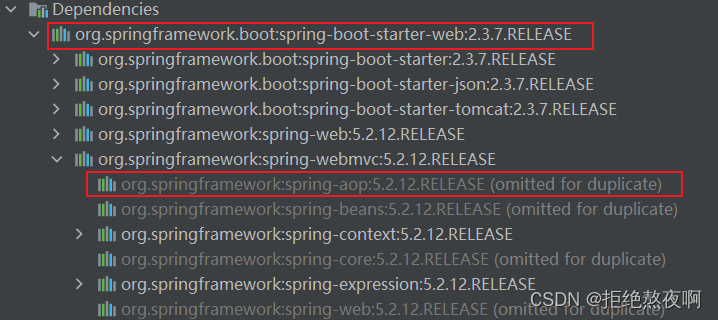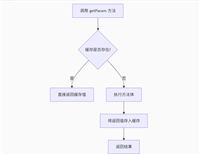一、aop概念
切面(aspect)
- 一个关注点的模块化,这个关注点可能会横切多个对象。
- 事务管理是j2ee应用中一个关于横切关注点的很好的例子。
- 在spring aop中,切面可以使用基于模式或者基于@aspect注解的方式来实现
连接点(joinpoint)
在程序执行过程中某个特定的点,比如某方法调用的时候或者处理异常的时候。在springaop中,一个连接点总是表示一个方法的执行
通知(advice)
- 在切面的某个特定的连接点上执行的动作。
- 其中包括了around、before和after等不同类型的通知。
- 许多aop框架(包括spring)都是以拦截器做通知模型,并维护一个以连接点为中心的拦截器链
切入点(pointcut)
- 匹配连接点的断言。
- 通知和一个切入点表达式关联,并在满足这个切入点的连接点上运行(例如,当执行某个特定名称的方法时),切入点表达式如何和连接点匹配是aop的核心:spring缺省使用aspectj切入点语法
引入(intorduction)
- 用来给一个类型声明额外的方法或属性(也被称为连接类型声明)。
- spring允许引入新的接口(以及一个对应的实现)到任何被代理的对象。
- 例如,你可以使用引入来使一个bean实现接口,以便简化缓存机制
目标对象(target object)
- 被一个或者多个切面所通知的对象。也被称做被通知对象。
- 既然spring aop是通过运行时代理实现的,这个对象永远是一个被代理对象
aop代理(aop proxy)
- aop框架创建的对象,用来实现切面契约(例如通知方法执行等等)。
- 在spring中,aop代理可以是jdk动态代理或者cglib代理
植入(weaving)
- 把切面连接到其它的应用程序类型或者对象上,并创建一个被通知的对象。
- 这些可以在编译时(例如使用aspectj编译器),类加载时和运行时完成。
- spring和其他纯java aop框架一样,在运行时完成织入
二、切点表达式
execution表达式
用于匹配方法执行的连接点,属于方法级别
语法:
execution(修饰符 返回值类型 方法名(参数)异常)
| 语法参数 | 描述 |
|---|---|
| 修饰符 | 可选,如public,protected,写在返回值前,任意修饰符填*号就可以 |
| 返回值类型 | 必选,可以使用*来代表任意返回值 |
| 方法名 | 必选,可以用*来代表任意方法 |
| 参数 | ()代表是没有参数,(..)代表是匹配任意数量,任意类型的参数,当然也可以指定类型的参数进行匹配,如要接受一个string类型的参数,则(java.lang.string), 任意数量的string类型参数:(java.lang.string..) |
| 异常 | 可选,语法:throws 异常,异常是完整带包名,可以是多个,用逗号分隔 |
符号:
| 符号 | 描述 |
|---|---|
| * | 匹配任意字符 |
| … | 匹配多个包或者多个参数 |
| + | 表示类及其子类 |
条件符:
| 符号 | 描述 |
|---|---|
| &&、and | 与 |
| || | 或 |
| ! | 非 |
案例
拦截com.gj.web包下的所有子包里的任意类的任意方法
execution(* com.gj.web..*.*(..))
拦截com.gj.web.api.test2controller下的任意方法
execution(* com.gj.web.api.test2controller.*(..))
拦截任何修饰符为public的方法
execution(public * * (..))
拦截com.gj.web下的所有子包里的以ok开头的方法
execution(* com.gj.web..*.ok*(..))
三、aop通知
在切面类中需要定义切面方法用于响应响应的目标方法,切面方法即为通知方法,通知方法需要用注解标识,aspectj支持5种类型的通知注解
| 注解 | 描述 |
|---|---|
| @before | 前置通知, 在方法执行之前执行 |
| @after | 后置通知, 在方法执行之后执行 |
| @afterreturn | 返回通知, 在方法返回结果之后执行 |
| @afterthrowing | 异常通知, 在方法抛出异常之后 |
| @around | 环绕通知,围绕方法的执行 |
@before
@before("testcut()")
public void cutprocess(joinpoint joinpoint) {
methodsignature signature = (methodsignature) joinpoint.getsignature();
method method = signature.getmethod();
system.out.println("注解方式aop开始拦截, 当前拦截的方法名: " + method.getname());
}
@after
@after("testcut()")
public void after(joinpoint joinpoint) {
methodsignature signature = (methodsignature) joinpoint.getsignature();
method method = signature.getmethod();
system.out.println("注解方式aop执行的方法 :"+method.getname()+" 执行完了");
}
@afterreturn:其中value表示切点方法,returning表示返回的结果放到result这个变量中
/**
* returning属性指定连接点方法返回的结果放置在result变量中
* @param joinpoint 连接点
* @param result 返回结果
*/
@afterreturning(value = "testcut()",returning = "result")
public void afterreturn(joinpoint joinpoint, object result) {
methodsignature signature = (methodsignature) joinpoint.getsignature();
method method = signature.getmethod();
system.out.println("注解方式aop拦截的方法执行成功, 进入返回通知拦截, 方法名为: "+method.getname()+", 返回结果为: "+result.tostring());
}
@afterthrowing:其中value表示切点方法,throwing表示异常放到e这个变量
@afterthrowing(value = "testcut()", throwing = "e")
public void afterthrow(joinpoint joinpoint, exception e) {
methodsignature signature = (methodsignature) joinpoint.getsignature();
method method = signature.getmethod();
system.out.println("注解方式aop进入方法异常拦截, 方法名为: " + method.getname() + ", 异常信息为: " + e.getmessage());
}
@around
@around("testcut()")
public object testcutaround(proceedingjoinpoint joinpoint) throws throwable {
system.out.println("注解方式aop拦截开始进入环绕通知.......");
object proceed = joinpoint.proceed();
system.out.println("准备退出环绕......");
return proceed;
}
四、springboot中使用aop
导出依赖
<dependency>
<groupid>org.springframework.boot</groupid>
<artifactid>spring-boot-starter-web</artifactid>
</dependency>

自定义注解
package com.hl.springbootrunner.aop;
import java.lang.annotation.elementtype;
import java.lang.annotation.retention;
import java.lang.annotation.retentionpolicy;
import java.lang.annotation.target;
@retention(retentionpolicy.runtime)
@target(elementtype.method)
public @interface aopannotations {
}
创建切面类
package com.hl.springbootrunner.aop;
import org.aspectj.lang.joinpoint;
import org.aspectj.lang.proceedingjoinpoint;
import org.aspectj.lang.annotation.*;
import org.aspectj.lang.reflect.methodsignature;
import org.springframework.stereotype.component;
import java.lang.reflect.method;
@aspect
@component
public class testaspect {
/**
* 这里的路径填自定义注解的全路径
*/
@pointcut("@annotation(com.hl.springbootrunner.aop.aopannotations)")
public void testcut() {
}
@before("testcut()")
public void cutprocess(joinpoint joinpoint) {
methodsignature signature = (methodsignature) joinpoint.getsignature();
method method = signature.getmethod();
system.out.println("注解方式aop开始拦截, 当前拦截的方法名: " + method.getname());
}
@after("testcut()")
public void after(joinpoint joinpoint) {
methodsignature signature = (methodsignature) joinpoint.getsignature();
method method = signature.getmethod();
system.out.println("注解方式aop执行的方法 :" + method.getname() + " 执行完了");
}
@around("testcut()")
public object testcutaround(proceedingjoinpoint joinpoint) throws throwable {
system.out.println("注解方式aop拦截开始进入环绕通知.......");
object proceed = joinpoint.proceed();
system.out.println("准备退出环绕......");
return proceed;
}
/**
* returning属性指定连接点方法返回的结果放置在result变量中
*
* @param joinpoint 连接点
* @param result 返回结果
*/
@afterreturning(value = "testcut()", returning = "result")
public void afterreturn(joinpoint joinpoint, object result) {
methodsignature signature = (methodsignature) joinpoint.getsignature();
method method = signature.getmethod();
system.out.println("注解方式aop拦截的方法执行成功, 进入返回通知拦截, 方法名为: " + method.getname() + ", 返回结果为: " + result.tostring());
}
@afterthrowing(value = "testcut()", throwing = "e")
public void afterthrow(joinpoint joinpoint, exception e) {
methodsignature signature = (methodsignature) joinpoint.getsignature();
method method = signature.getmethod();
system.out.println("注解方式aop进入方法异常拦截, 方法名为: " + method.getname() + ", 异常信息为: " + e.getmessage());
}
}
自定义一个接口
@restcontroller
public class testcontroller {
@getmapping("/ok")
@aopannotations
public string test2() {
return "ok";
}
}
测试

总结
以上为个人经验,希望能给大家一个参考,也希望大家多多支持代码网。






发表评论